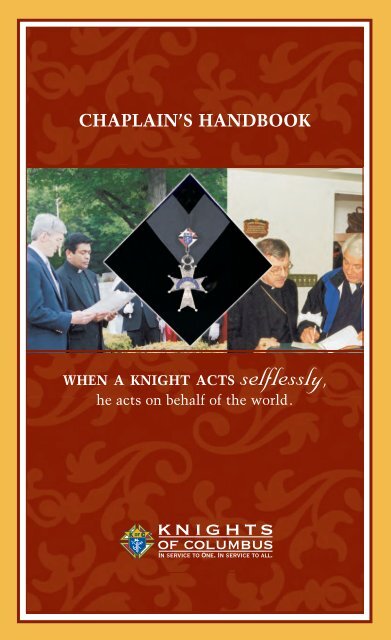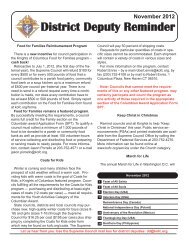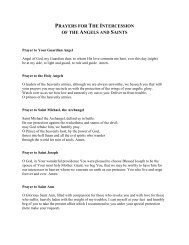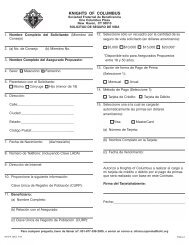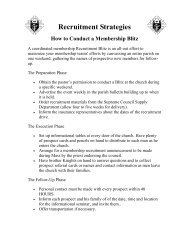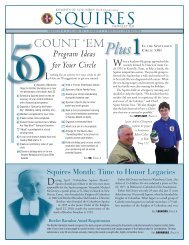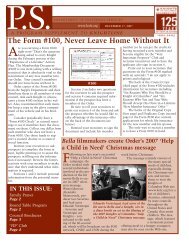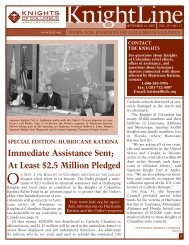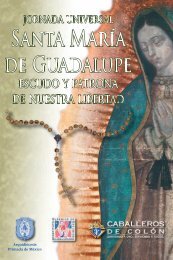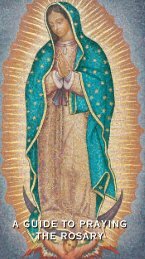Chaplain's Handbook (#945) - Knights of Columbus, Supreme Council
Chaplain's Handbook (#945) - Knights of Columbus, Supreme Council
Chaplain's Handbook (#945) - Knights of Columbus, Supreme Council
Create successful ePaper yourself
Turn your PDF publications into a flip-book with our unique Google optimized e-Paper software.
CHAPLAIN’S HANDBOOK<br />
WHEN A KNIGHT ACTS selflessly,<br />
he acts on behalf <strong>of</strong> the world.
CHAPLAIN’S<br />
HANDBOOK<br />
KNIGHTS OF COLUMBUS<br />
SUPREME COUNCIL HEADQUARTERS<br />
1 COLUMBUS PLAZA<br />
NEW HAVEN, CONNECTICUT 06510-3326
FOREWORD<br />
The material in this manual is not intended to be all-inclusive,<br />
since many activities which may be appropriate will be governed<br />
by local conditions. This manual is a guide to assist all council<br />
chaplains in the execution <strong>of</strong> their duties and to increase the<br />
understanding among council <strong>of</strong>ficers <strong>of</strong> the chaplain’s role in<br />
the success <strong>of</strong> the council.<br />
It would be appreciated if, when a chaplain is being<br />
transferred, he would deliver the manual to his successor, so<br />
that the new chaplain will have it immediately after his<br />
appointment.
TABLE OF CONTENTS<br />
Chaplain’s Appointment ...................................................... 7<br />
Role <strong>of</strong> the Chaplain............................................................ 7<br />
Organized Activity ............................................................... 9<br />
Nature <strong>of</strong> the Order ............................................................. 10<br />
Working with the <strong>Council</strong> .................................................... 13<br />
Working in the Community.................................................. 16<br />
Qualifications for Membership ............................................ 17<br />
The Life and Times <strong>of</strong> Father McGivney ............................. 19<br />
5
THE CHAPLAIN’S APPOINTMENT<br />
The laws <strong>of</strong> the <strong>Knights</strong> <strong>of</strong> <strong>Columbus</strong> (Section 128) state:<br />
“The Grand Knight, Deputy Grand Knight and Board <strong>of</strong><br />
Trustees may annually select a priest to act as Chaplain, but<br />
such selection must be made in accordance with any rules<br />
established by the bishop <strong>of</strong> the diocese in which the council<br />
is located.”<br />
Therefore, the laws provide that the chaplain shall be a<br />
priest and that the selection be made by specific <strong>of</strong>ficers <strong>of</strong> the<br />
council – the grand knight, deputy grand knight and board <strong>of</strong><br />
trustees.<br />
It is the responsibility <strong>of</strong> the grand knight to determine<br />
what, if any, rules the bishop <strong>of</strong> the diocese has established for<br />
the appointment <strong>of</strong> chaplains. If such rules have been<br />
established, they must be followed.<br />
ROLE OF THE CHAPLAIN<br />
The chaplain <strong>of</strong> a <strong>Knights</strong> <strong>of</strong> <strong>Columbus</strong> council . . . must<br />
recognize that the Order is a Catholic lay organization founded<br />
by a priest. Father McGivney founded the Order, to be sure,<br />
but it was administered and supported by Catholic laymen. In<br />
our day, especially with the Second Vatican <strong>Council</strong> and<br />
Revised Code <strong>of</strong> Canon Law in 1983, specifying clearly and<br />
unequivocally the rights and duties <strong>of</strong> the Catholic laity, the<br />
<strong>Knights</strong> <strong>of</strong> <strong>Columbus</strong> itself, as a fraternal society, has its own<br />
special role to play in the Church. The chaplain, who always is<br />
a priest, must recognize this fact and rejoice in it.<br />
Given his education and priestly formation, and as founder<br />
<strong>of</strong> the Order, Father McGivney might well say that it is the<br />
priest-chaplain who is called to exercise his apostolic ministry<br />
for the <strong>Knights</strong> and their families, even as he is called to do so<br />
for all those to whom he has been assigned. For the council,<br />
7
and in collaboration with his bishop, he is the teacher, the<br />
shepherd, the sanctifier <strong>of</strong> souls.<br />
Since it is his calling and therefore his duty, he should<br />
collaborate with local, state and supreme <strong>of</strong>ficers to develop<br />
ways and means to preach God’s Word to brother <strong>Knights</strong> and<br />
their families, to help them to be more firmly rooted in faith,<br />
hope, and charity, and to further their growth in the knowledge<br />
<strong>of</strong> their Catholic faith so as to be able witnesses <strong>of</strong> the mystery<br />
<strong>of</strong> salvation everywhere and to everyone. The <strong>Knights</strong> <strong>of</strong><br />
<strong>Columbus</strong> provide for the priest-chaplain-teacher a ready<br />
audience and even more, a docile one, eager to be taught<br />
more about the faith and the Catholic Church.<br />
Like Father McGivney, the priest-chaplain is a shepherd <strong>of</strong><br />
the flock. The Order represents a special flock, one that is<br />
highly organized, one, as we know, that is specifically<br />
structured – even worldwide. Surely the priest-chaplain must<br />
want to know his flock, to help individuals be faithful, for their<br />
families to be true “domestic churches,” and for his council to<br />
be dedicated to the ideals <strong>of</strong> the Order. All these duties are<br />
integrated into the apostolic mission <strong>of</strong> the Church.<br />
As a priest he is present as much as possible to encourage<br />
special attention to adolescents and youth, to be available to<br />
the poor and elderly, to the disabled and underprivileged. For<br />
in all these areas <strong>of</strong> charitable and social service activities are<br />
to be found <strong>Knights</strong> <strong>of</strong> <strong>Columbus</strong> and their families. The<br />
chaplain’s presence by word and example has an impact and<br />
influence that only the Lord can measure. <strong>Knights</strong> love their<br />
priests . . . and like to have them around as good shepherds.<br />
Perhaps since Father McGivney himself was a very holy<br />
priest, he would highlight the sanctifying role <strong>of</strong> the priestchaplain.<br />
Surely he would note the importance, the essential<br />
character, <strong>of</strong> the Eucharistic celebration in the lives <strong>of</strong> <strong>Knights</strong><br />
and their families. For the Eucharistic sacrifice “is the center<br />
and culmination <strong>of</strong> the whole life <strong>of</strong> the Christian community”<br />
and certainly <strong>of</strong> the <strong>Knights</strong> <strong>of</strong> <strong>Columbus</strong> council on every<br />
8
level. As chaplain, he would plan with <strong>of</strong>ficers and members<br />
the ways and means to promote attendance at Mass, even<br />
daily Mass, the frequent and fervent reception <strong>of</strong> the<br />
Sacraments, especially <strong>of</strong> penance and reconciliation and, <strong>of</strong><br />
course, the “trademark” <strong>of</strong> the Order, the recitation <strong>of</strong> Our<br />
Lady’s Rosary. For it is holiness that is the priority for the<br />
chaplain; that identification with the Lord Jesus that provides<br />
the impulse, the power for mission.<br />
How would Father McGivney summarize the role <strong>of</strong> the<br />
chaplain? Maybe he would paraphrase the old definition <strong>of</strong> the<br />
priest:<br />
To live in the midst <strong>of</strong> the community and council without<br />
wishing to dominate by direction. To be a member <strong>of</strong> each<br />
council and <strong>of</strong> each member’s family but possessed by none,<br />
to feel all suffering; to penetrate all secrets; to heal all wounds;<br />
to go from <strong>Knights</strong> and their families to God and <strong>of</strong>fer Him their<br />
praise; to return from God to <strong>Knights</strong> and their families to bring<br />
God and hope; to have a heart <strong>of</strong> fire for charity and a heart <strong>of</strong><br />
bronze for chastity; to teach, to pardon, console and bless<br />
always. My God, what a singular privilege is yours, priestchaplain<br />
<strong>of</strong> the <strong>Knights</strong> <strong>of</strong> <strong>Columbus</strong>.<br />
ORGANIZED ACTIVITY<br />
A priest has many obligations in his parish which require his<br />
time and his effort. Therefore, as early as possible – preferably<br />
in June, after the election <strong>of</strong> <strong>of</strong>ficers – there should be a<br />
meeting <strong>of</strong> the council <strong>of</strong>ficers, including the council chaplain,<br />
for the purpose <strong>of</strong> discussing the particular programs in which<br />
the council chaplain will participate.<br />
Also, as soon as the director <strong>of</strong> Church activities has been<br />
appointed, he and and his committee chairmen should meet<br />
with the council chaplain and discuss a tentative program for<br />
the year and to determine the particular participation <strong>of</strong> the<br />
chaplain in these programs.<br />
The council chaplain is a member <strong>of</strong> the council vocations<br />
committee and can be especially helpful to the chairman <strong>of</strong> this<br />
9
committee. The programs developed by the <strong>Supreme</strong> <strong>Council</strong><br />
Vocations Committee and the state vocations committee<br />
should be implemented on the local level, along with other<br />
programs developed specifically within the diocese and by the<br />
council. Many <strong>of</strong> these programs are described in the<br />
Vocations <strong>Handbook</strong> (#1492) and the Surge . . . with Service<br />
booklet (#962) included in the “Surge . . . with Service” kit<br />
mailed at the start <strong>of</strong> the fraternal year to every financial<br />
secretary <strong>of</strong> record.<br />
NATURE OF THE ORDER<br />
It is well that the nature and objectives <strong>of</strong> the Order be<br />
understood. The <strong>Knights</strong> <strong>of</strong> <strong>Columbus</strong> was organized as a<br />
fraternal benefit society in New Haven, Conn., in 1882 by the<br />
Reverend Michael Joseph McGivney, a curate at St. Mary’s<br />
Parish in New Haven, and a small group <strong>of</strong> Catholic men for the<br />
primary purpose <strong>of</strong> providing protection for the families <strong>of</strong> its<br />
members. The Order was granted a charter by the Legislature<br />
<strong>of</strong> the State <strong>of</strong> Connecticut on March 29, 1882. The charter has<br />
been so amended as to now provide that “the purposes for<br />
which said corporation is formed are the following –<br />
(a) <strong>of</strong> rendering pecuniary aid to its members and their<br />
families;<br />
(b) <strong>of</strong> rendering mutual aid and assistance to its sick,<br />
disabled and needy members;<br />
(c) <strong>of</strong> promoting social and intellectual intercourse among<br />
its members; and<br />
(d) <strong>of</strong> promoting and conducting educational, charitable,<br />
religious, social welfare, war relief and welfare and<br />
public relief work.”<br />
Consequently, under its charter, as the program <strong>of</strong> the<br />
Order has been expanded to meet particular needs, its history<br />
is filled with examples <strong>of</strong> outstanding contributions to Church,<br />
state and community. Whenever and wherever there is a need<br />
10
for the strength available in an organized body <strong>of</strong> loyal Catholic<br />
laymen, the <strong>Knights</strong> <strong>of</strong> <strong>Columbus</strong> – by the very nature <strong>of</strong> its<br />
organization – is able to respond quickly and efficiently. A few<br />
examples <strong>of</strong> such areas <strong>of</strong> K <strong>of</strong> C involvement include:<br />
– strengthening family life;<br />
– reaching out to widows and children <strong>of</strong> deceased<br />
brother <strong>Knights</strong>;<br />
– promoting devotion to the Blessed Sacrament;<br />
– defending the unborn and aged;<br />
– encouraging frequent and heartfelt recitation <strong>of</strong> the Holy<br />
Rosary;<br />
– working to increase awareness <strong>of</strong> every Catholic’s<br />
Christian vocation and taking an active part in the<br />
recruitment <strong>of</strong> candidates for Church-related vocations;<br />
– providing assistance to hungry, homeless, physically<br />
and mentally handicapped individuals and anyone in<br />
need.<br />
These are illustrative <strong>of</strong> the type <strong>of</strong> programs in which the<br />
Order has participated. Local councils, under the guidance <strong>of</strong><br />
their council chaplains, can join in any and all <strong>of</strong> these<br />
Orderwide efforts. In 2011, through such programs, as well as<br />
local initiatives, the <strong>Knights</strong> <strong>of</strong> <strong>Columbus</strong> donated over $162<br />
million to charitable causes and volunteered 70 million hours <strong>of</strong><br />
community service.<br />
In addition to programs on an international or national<br />
level, countless useful religious activities are being promoted<br />
by <strong>Knights</strong> <strong>of</strong> <strong>Columbus</strong> everywhere. A narration <strong>of</strong> such<br />
projects would fill many pages, but typical are such<br />
programs as assistance to parish priests and bishops in their<br />
local areas, cooperation with other Catholic groups in various<br />
projects, participation in Catholic fund drives, direct financial<br />
11
assistance to parishes, financial contributions to the missions<br />
and the poor, donation <strong>of</strong> the use <strong>of</strong> council facilities to other<br />
Catholic groups, sponsorship <strong>of</strong> religious celebrations, financial<br />
assistance to seminarians, Catholic press promotion, sponsor -<br />
ship <strong>of</strong> “Chaplain’s Message” and lectures, distribution <strong>of</strong><br />
Catholic pamphlets and magazines, opposition to anti-religious<br />
legisla tion, sponsorship <strong>of</strong> Cana conferences, promotion <strong>of</strong><br />
commu nity retreats, sponsorship <strong>of</strong> protests against indecent<br />
en tertainment, literature, etc.<br />
In particular, the Order encourages vocations to the priest -<br />
hood and religious life through the Refund Support Vocations<br />
Program (RSVP), a program <strong>of</strong> direct financial and moral<br />
support <strong>of</strong> seminarians and postulants. A detailed outline <strong>of</strong><br />
RSVP, as well as a description <strong>of</strong> suggested council vocations<br />
initiatives, is contained in the Vocations <strong>Handbook</strong> (#1942). A<br />
copy <strong>of</strong> this handbook is provided in the “Surge . . . with<br />
Service” programming kit for the council chaplain’s use.<br />
<strong>Council</strong> chaplains receive Columbia magazine and<br />
Knightline. Each issue <strong>of</strong> Columbia includes articles on a wide<br />
variety <strong>of</strong> subjects <strong>of</strong> interest to members and their families.<br />
Projects and initiatives within the Order’s far-flung membership<br />
are described and illustrated in reports and photographs. Of<br />
particular interest is the monthly column written by <strong>Supreme</strong><br />
Chaplain Archbishop William E. Lori.<br />
Knightline, sent monthly to council leaders, covers the<br />
activities <strong>of</strong> the <strong>Supreme</strong> <strong>Council</strong> <strong>of</strong>fice and reports on fastbreaking<br />
news <strong>of</strong> importance to the Order, as well as current<br />
ideas, suggestions and guidelines to assist the program and<br />
member ship chairmen in the discharge <strong>of</strong> their duties.<br />
As an organization <strong>of</strong> Catholic men who are conscious <strong>of</strong><br />
their responsibilities to the mission <strong>of</strong> Christ in the Church, the<br />
<strong>Knights</strong> <strong>of</strong> <strong>Columbus</strong> look to their chaplains for encouragement<br />
and guidance so that their motivation may be duly spiritual and<br />
their thinking in harmony with the teaching <strong>of</strong> the Church and<br />
the policies <strong>of</strong> the local bishop and pastors.<br />
12
The membership strength <strong>of</strong> the Order, its chain <strong>of</strong> organi -<br />
zation and its record <strong>of</strong> accomplishment make possible the<br />
undertaking and effective implementation <strong>of</strong> major projects in<br />
support <strong>of</strong> the Church.<br />
WORKING WITH THE COUNCIL<br />
Due to the nature <strong>of</strong> his <strong>of</strong>fice, the chaplain can render<br />
service to the council and its members and, through the<br />
council, to the community in which the council operates.<br />
ATTENDANCE AT MEETINGS AND ACTIVITIES – It is<br />
desirable that the chaplain attend all the meetings <strong>of</strong> the council,<br />
including the <strong>of</strong>ficers’ meetings. His advice is frequently needed<br />
by the <strong>of</strong>ficers and members, and his absence may result in the<br />
delay <strong>of</strong> important decisions that are to be made and voted<br />
upon. It is recognized, however, that the parochial duties <strong>of</strong> a<br />
chaplain may make it difficult for him to attend all meetings <strong>of</strong><br />
the coun cil. When this happens, the chaplain should attempt<br />
to find a substitute – another priest or a deacon or seminarian<br />
– to take his place at that particular meeting. At times there is<br />
discussion <strong>of</strong> controversial issues in which strong personal<br />
opinions and feelings may play a part. The presence <strong>of</strong> the<br />
chaplain may well, and frequently does, keep strong feelings<br />
under control. In his presence, harsh and rash words will<br />
remain unsaid and hasty thoughts will remain unexpressed.<br />
However, in his participation in such discussions, it should be<br />
made clear that there must be at all times free and honest<br />
expression <strong>of</strong> thoughtful opinion. The examples <strong>of</strong> the<br />
chaplain’s own moderation will contribute greatly to the orderly<br />
conduct <strong>of</strong> such discussions.<br />
The presence <strong>of</strong> the chaplain at meetings adds greatly to<br />
the dignity and importance <strong>of</strong> the meetings. The prayers he<br />
says and the opinions he expresses will constitute a basic<br />
spiritual good to the council and to the members, which<br />
cannot be supplied by any lay member.<br />
As outlined in the “Order <strong>of</strong> Business” card (#1937),<br />
provided in the “Surge . . . with Service” kit, the chaplain<br />
should be called on during each council meeting to report on<br />
any business matters relative to his <strong>of</strong>fice. Normally he will also<br />
13
eflect on matters <strong>of</strong> a religious nature immediately preceeding<br />
the grand knight’s report or whenever he so desires. He may<br />
choose to use this time to discuss planned Church activities or,<br />
since he is a member <strong>of</strong> the council’s vocations committee, he<br />
may use this time to update members on the status <strong>of</strong> the<br />
council’s vocations committee.<br />
The Order recognizes that regular attendance may at times<br />
involve considerable sacrifice, but the influence <strong>of</strong> the<br />
chaplain’s presence means so much that it is hoped that each<br />
chaplain will make the utmost effort to attend every meeting<br />
possible.<br />
STATE COUNCIL MEETINGS – The annual meeting <strong>of</strong> the<br />
state council affords an opportunity to see Columbianism at<br />
work at the state level. At meetings <strong>of</strong> chaplains in which the<br />
matter was discussed at great length, it was the consensus <strong>of</strong><br />
opinion that while there may be times when it would be<br />
expedient for a chaplain to attend as a delegate, it is usually<br />
more desirable for him to attend as a chaplain. By arrangement<br />
with the state deputy, an opportunity might be provided for an<br />
informal meeting <strong>of</strong> the chaplains present at which they could<br />
discuss their own particular concerns. Arrangement for the<br />
chaplain’s attendance to observe the operation <strong>of</strong> the state<br />
council meeting, to learn in detail <strong>of</strong> the business <strong>of</strong> the Order<br />
at the state level and to obtain additional information from<br />
fellow chaplains would be made by his council and it would<br />
provide for the small expense which his attendance would<br />
involve.<br />
The state council meeting usually opens with a solemn<br />
Mass, and in most jurisdictions a requiem Mass is held on the<br />
second day for the deceased members throughout the state.<br />
In co operation with the state chaplain, the chaplains <strong>of</strong> the<br />
local councils could invite all <strong>of</strong> the clergy <strong>of</strong> the city to attend<br />
these functions. This is particularly important when the<br />
ordinary <strong>of</strong> the diocese presides at the opening Mass.<br />
QUALIFICATIONS OF MEMBERS – Active participation <strong>of</strong><br />
the chaplain in the meetings and programs <strong>of</strong> the council <strong>of</strong>fers<br />
14
him a constant opportunity to impress upon the <strong>of</strong>ficers and<br />
members the required qualification for membership in the<br />
Order – practical Catholicity. (See pages 17-19). Whenever<br />
there is a question <strong>of</strong> a member’s failure to remain a practical<br />
Catholic, the <strong>of</strong>ficers should consult with the chaplain and the<br />
member’s pastor so that no injustice will be done and no unjust<br />
or un-Christian gossip is permitted to be spread. If the<br />
situation cannot be adjusted satisfactorily, the laws <strong>of</strong> the<br />
Order provide appropriate procedures for the exclusion <strong>of</strong> such<br />
a one from membership in the Order.<br />
HELPFUL ADVICE — When the different committee<br />
members are outlining their programs for the year, the chaplain<br />
can be most helpful by <strong>of</strong>fering advice on the types <strong>of</strong><br />
programs to be conducted and the procedures to be followed.<br />
He will know, for example, whether any <strong>of</strong> the programs under<br />
discussion would conflict with similar programs already in<br />
operation under the auspices <strong>of</strong> other groups <strong>of</strong> Catholics. He<br />
can <strong>of</strong>fer suggestions as to the proper procedures to be<br />
followed. For example, the chaplain could suggest how to<br />
arrange for a corporate communion or conduct a special<br />
vocations recruitment activity. Such suggestions might include<br />
contacting the pastor <strong>of</strong> the church where an event is to be<br />
held, providing him with full information prior to any<br />
announcement <strong>of</strong> the activity. Arrangements for the date and<br />
time could then be cleared before the committee proceeds<br />
with plans.<br />
SPIRITUAL PRESENCE – The presence <strong>of</strong> the chaplain to<br />
lead the prayers at the wakes <strong>of</strong> members <strong>of</strong> a council is vitally<br />
important. His presence <strong>of</strong>fers spiritual solace to the bereaved<br />
family and good example to the members <strong>of</strong> the council. The<br />
chaplain can encourage the holding <strong>of</strong> an annual memorial<br />
Mass in memory <strong>of</strong> deceased members, make the<br />
presentation <strong>of</strong> a chalice to a missionary priest, assist in<br />
arranging for spiritual bouquets, etc.<br />
CHAPLAIN’S COLUMN – Another means by which the<br />
chaplain may help to provide information concerning Catholic<br />
15
doctrine and liturgy is through a “Chaplain’s Column” in the<br />
council bulletin. We know that not all members attend council<br />
meetings, and, therefore, the chaplain’s influence can be<br />
expanded by his presenting regularly some Catholic<br />
information through this column. Early in the term the chaplain<br />
should consult with the editor <strong>of</strong> the council bulletin to<br />
determine the deadline for copy and the approximate number<br />
<strong>of</strong> words he should provide for publication each month. In this<br />
way, the members who are not present at council meetings will<br />
also have the benefit <strong>of</strong> the teaching ministry <strong>of</strong> the chaplain.<br />
WORKING IN THE COMMUNITY<br />
The following suggestions – covering some phases <strong>of</strong> a<br />
chaplain’s participation in the work <strong>of</strong> his council and the Order<br />
– clearly indicate that great good can come from the work and<br />
the influence <strong>of</strong> a chaplain. It affords him the opportunity to<br />
work among Catholic men and to inspire, direct and instruct<br />
them as such.<br />
COMMITTEE WORK – Through the operations <strong>of</strong> the<br />
different committees, in cooperation with the council chaplain,<br />
the influence <strong>of</strong> the council may become widespread in the<br />
community. For example, the chaplain can assist in arranging<br />
for the presentation <strong>of</strong> public forums or lecture series. The<br />
Lenten season is an excellent time for giving such a series, which<br />
can be held on Sunday afternoon or on a specified evening<br />
during each <strong>of</strong> the first four weeks <strong>of</strong> Lent. The program may<br />
consist <strong>of</strong> a prepared talk on an assigned topic by a speaker or<br />
forum leaders, followed by questions from the audience. The<br />
submission <strong>of</strong> questions in writing is found to be desirable<br />
because many people who might wish to get information may be<br />
timid about asking a question orally, and they enable the forum<br />
leaders to eliminate questions not pertinent to the subject being<br />
discussed in that particular forum or lecture. They also enable<br />
the leader to combine several questions which are closely<br />
related and thereby avoid duplication <strong>of</strong> answers. Religious<br />
16
teaching, vocations, family life, social questions and the like<br />
are all suitable forum subjects.<br />
Annually the council might conduct a “Clergy Night” to<br />
which all priests in the community would be invited, for the<br />
dual purpose <strong>of</strong> discussing the work <strong>of</strong> the Order with the<br />
priests and <strong>of</strong> determining projects <strong>of</strong> local Catholic interest<br />
in which the council can cooperate. The chaplain could be<br />
very helpful in such a project by sending invitations to the<br />
priests over his signature, by contacting them personally<br />
and by assisting in preparing the program and making<br />
arrangements for the meeting.<br />
CONTROVERSIAL QUESTIONS – Occasionally there arise<br />
in a community, in a jurisdiction or in a nation controversial<br />
questions in which the position <strong>of</strong> the Church or <strong>of</strong> Catholics is<br />
involved. Before any public action is taken with regard to such<br />
a matter, the council <strong>of</strong>ficers and the committee chairmen in -<br />
volved should sit down with the chaplain and discuss the<br />
matter thoroughly, so that if the council does take a position,<br />
or if it should ask its members to take a position, the question<br />
will be thoroughly understood and handled properly.<br />
GOOD EXAMPLE – One <strong>of</strong> the most important contributions<br />
a council may make to the life <strong>of</strong> its community is the example<br />
given by its members in their religious, social and business lives.<br />
For this purpose the presence <strong>of</strong> the chaplain at as many council<br />
meetings and activities as possible is highly desirable, enabling<br />
him to emphasize in his talks and in his conversations the<br />
importance <strong>of</strong> members <strong>of</strong> the Order giving outstanding<br />
example in their communities.<br />
QUALIFICATIONS FOR MEMBERSHIP<br />
IN THE KNIGHTS OF COLUMBUS<br />
The qualifications for membership in the <strong>Knights</strong> <strong>of</strong><br />
<strong>Columbus</strong> are set down in Section 101 <strong>of</strong> the Laws <strong>of</strong> the Order.<br />
They are as follows: “Only practical Catholics in union with the<br />
Holy See shall be eligible to and entitled to continue membership<br />
in the Order. An applicant for membership shall not be less than<br />
18 years <strong>of</strong> age on his last birthday.”<br />
17
There are no other requirements. Nothing is said about the<br />
candidate’s pr<strong>of</strong>ession, education, national background, the color<br />
<strong>of</strong> his skin, his nationality, his cultural level or his financial status.<br />
PRACTICAL CATHOLIC–Guidelines have been established<br />
to assist in judging the practical Catholicity <strong>of</strong> an applicant or<br />
member. Those guidelines also appear in our Grand Knight’s<br />
<strong>Handbook</strong> (#915) so that the grand knight can perform his<br />
duties as an informed and responsible Catholic gentleman<br />
when con ducting sessions <strong>of</strong> his council’s Admission<br />
Committee. The main components <strong>of</strong> this requirement may be<br />
described as follows:<br />
• A practical Catholic accepts the teaching authority <strong>of</strong> the<br />
Catholic Church on matters <strong>of</strong> faith and morals, aspires<br />
to live in accord with the precepts <strong>of</strong> the Catholic<br />
Church, and is in good standing in the Catholic Church.<br />
• A practical Catholic strives to have a greater knowledge<br />
<strong>of</strong> the teachings <strong>of</strong> Christ and his Church, and to<br />
accept, respect and defend the Church’s authority<br />
(vested in the <strong>Supreme</strong> Pontiff, the hierarchy and clergy<br />
united with him) to teach, govern and sanctify the<br />
faithful.<br />
• A practical Catholic gives material and moral support to<br />
the Church and her works on all levels, promoting the<br />
programs <strong>of</strong> the parish and diocese and comes to the<br />
aid <strong>of</strong> the missions, the needy, the underprivileged;<br />
espousing and advancing the just causes <strong>of</strong> minority<br />
groups; endeavoring to eliminate unjust discrimination,<br />
prejudice, etc.; sup porting the Church in her defense <strong>of</strong><br />
marriage and family life and in her crusades against<br />
divorce, abortion, pornography and all the evils <strong>of</strong> today.<br />
• If a Catholic marries outside the Church, that is,<br />
contrary to the laws <strong>of</strong> the Church, he ceases to be a<br />
practical Catholic and hence may not be a member <strong>of</strong><br />
the <strong>Knights</strong> <strong>of</strong> <strong>Columbus</strong>. A man who, living in a valid<br />
marriage, obtains a civil divorce and remarries outside<br />
the Church ceases to be a practical Catholic and hence<br />
loses his right to join or continue in the Order <strong>of</strong> the<br />
<strong>Knights</strong> <strong>of</strong> <strong>Columbus</strong>. If his former marriage is declared<br />
null by the Church and he remarries validly according to<br />
the Church’s laws, he may be reinstated into the Order.<br />
18
• A Catholic who is a member <strong>of</strong> a forbidden, secret<br />
society is not a practical Catholic and hence may not<br />
become or continue to be a member <strong>of</strong> the <strong>Knights</strong> <strong>of</strong><br />
<strong>Columbus</strong>.<br />
OTHER CONSIDERATIONS – If a member <strong>of</strong> the Order is<br />
married, he should be a faithful and devoted husband and<br />
father. Married or unmarried, the Knight should always be an<br />
exemplarly Catholic gentleman and a dutiful patriotic citizen.<br />
DETERMINING QUALIFICATION – Before a candidate is<br />
presented for membership, his sponsor should be sure that the<br />
candidate possesses and manifests the necessary qualifications<br />
for membership. These are then appraised by the Admission<br />
Committee and a subsequent ballot by the membership deter -<br />
mines acceptance or rejection. This is in keeping with the<br />
lodge system under which the Order <strong>of</strong> the <strong>Knights</strong> <strong>Columbus</strong><br />
operates. If questions arise at any time during the admission<br />
process as to the candidate’s practical Catholicity, the<br />
proposer or the Admissions Committee should consult the<br />
council chaplain and/or the candidate’s pastor.<br />
THE LIFE AND TIMES OF FATHER McGIVNEY<br />
During his tenure, a council chaplain may be called upon to<br />
speak about another priest whose importance to the Order is<br />
pr<strong>of</strong>ound – Father Michael J. McGivney, founder <strong>of</strong> the <strong>Knights</strong><br />
<strong>of</strong> <strong>Columbus</strong>. All chaplains are in a sense asked to carry on the<br />
legacy <strong>of</strong> this holy priest. The following article can be valuable<br />
to a chaplain, both as information useful in preparing council<br />
programs and as insight into the history <strong>of</strong> our Order, its<br />
founder and the relationship between the lay members <strong>of</strong> the<br />
<strong>Knights</strong> <strong>of</strong> <strong>Columbus</strong> and the clergy they look to for guidance.<br />
THE LIFE AND TIMES OF<br />
FATHER MICHAEL J. McGIVNEY<br />
In mid-August <strong>of</strong> 1890 one <strong>of</strong> the largest funerals in the history <strong>of</strong> Waterbury,<br />
Conn., took place. The throngs who attended were grieving the death, at age 38, <strong>of</strong><br />
Father Michael J. McGivney, founder <strong>of</strong> the <strong>Knights</strong> <strong>of</strong> <strong>Columbus</strong>.<br />
19
Delegations were present from almost<br />
every one <strong>of</strong> the 57 K <strong>of</strong> C councils which had<br />
sprung up in the Order’s first eight years. The<br />
bishop <strong>of</strong> Hartford and more than 70 <strong>of</strong><br />
Connecticut’s Catholic priests were joined by<br />
many civic leaders. It was reported that every<br />
available carriage for miles around had been<br />
rented for the great procession.<br />
Father McGivney’s funeral was an<br />
indication <strong>of</strong> the love and respect the people<br />
felt for this hard-working, holy parish priest. It<br />
also reflected the deep personal appeal that<br />
im migrant Catholics immediately found in the<br />
<strong>Knights</strong> <strong>of</strong> <strong>Columbus</strong>. The Order has never<br />
since ceased to grow. Today it is the largest<br />
society <strong>of</strong> Catholic men in the world, with<br />
nearly two million members in the United<br />
States, Canada, the Philippines, Mexico,<br />
Poland, and several Central American and<br />
Caribbean countries.<br />
Reverend Michael J. McGivney<br />
To mark their hundredth anniversary in<br />
1982, the <strong>Knights</strong> <strong>of</strong> <strong>Columbus</strong> brought the remains <strong>of</strong> Father McGivney from<br />
Waterbury back to St. Mary’s Church in New Haven, where he had founded the<br />
Order. There he now rests in a setting in which daily Mass is <strong>of</strong>fered for the<br />
deceased members <strong>of</strong> the Order and their wives and prayers are said in his honor.<br />
Father Michael McGivney was born in Waterbury on Aug. 12, 1852. His parents<br />
Patrick and Mary (Lynch) McGivney, had arrived in the great 19th Century wave <strong>of</strong><br />
Irish immigration. Patrick McGivney became a molder in the heat and noxious<br />
fumes <strong>of</strong> a Waterbury brass mill. Mary McGivney gave birth to 13 children, six <strong>of</strong><br />
whom died in infancy or childhood. So their first child, Michael, with four living<br />
sisters and two brothers, learned early about sorrow, and the harsh grip <strong>of</strong> poverty.<br />
He also learned about the powers <strong>of</strong> love, and faith and family fortitude.<br />
He went to the small district schools <strong>of</strong> Waterbury’s working-class<br />
neighborhoods. A good child, he was admired by his school principal for “excellent<br />
deportment and pr<strong>of</strong>iciency in his studies.” Then, after the Civil War, when the<br />
Connecticut metals industry was booming, he left school at age 13 to go to work.<br />
His job in the spoon-making department <strong>of</strong> a brass factory provided a few more<br />
dollars for family survival.<br />
When Michael reached the age <strong>of</strong> 16 in 1868, he left the factory. With the<br />
priesthood clearly in mind, he traveled with his Waterbury pastor to Quebec,<br />
Canada. There he registered at the French-run College <strong>of</strong> St. Hyacinthe. He worked<br />
hard on subjects which would prepare him to apply for seminary admission.<br />
Two academic years followed at Our Lady <strong>of</strong> Angels Seminary, attached to<br />
Niagara University in Niagara Falls, N.Y. Young McGivney moved next to Montreal<br />
to attend seminary classes at the Jesuit-run St. Mary’s College. He was there when<br />
his father died in 1873.<br />
20
Lacking funds and concerned about his family, he went home to the funeral,<br />
lingering a while in Waterbury. Then, at the request <strong>of</strong> the bishop <strong>of</strong> Hartford, he<br />
entered St. Mary’s Seminary in Baltimore. After four years <strong>of</strong> study, on December<br />
22, 1877, he was ordained in Baltimore’s historic Cathedral <strong>of</strong> the Assumption by<br />
Archbishop (later cardinal) James Gibbons. A few days later, with his widowed<br />
mother present, he said his first Mass at Immaculate Conception Church in<br />
Waterbury.<br />
Father McGivney began his priestly ministry on Christmas Day in 1877 as<br />
curate <strong>of</strong> St. Mary’s Church in New Haven. It was the city’s first parish. A new stone<br />
church had been built, after the old one burned, on one <strong>of</strong> New Haven’s finest<br />
residential streets, Hillhouse Avenue. There was neighborhood objection which<br />
even The New York Times noted in 1879, under the headline, “How An Aristocratic<br />
Avenue Was Blemished By A Roman Church Edifice.” So Father McGivney’s priestly<br />
ministry in New Haven began with tension and defensiveness among the workingclass<br />
Irish families he served.<br />
One <strong>of</strong> the responsibilities <strong>of</strong> St. Mary’s priests was pastoral care <strong>of</strong> inmates <strong>of</strong><br />
the city jail. In a notable case, a 21-year-old Irishman, while drunk, shot and killed a<br />
police <strong>of</strong>ficer. James (Chip) Smith was tried for first-degree murder in 1881,<br />
convicted and sentenced to be hung. Father McGivney visited him daily. After a<br />
special Mass on the day <strong>of</strong> execution, the priest’s grief was intense. The young<br />
<strong>of</strong>fender comforted him: “Father, your saintly ministrations have enabled me to meet<br />
death without a tremor. Do not fear for me, I must not break down now.”<br />
Father McGivney worked closely with the young people <strong>of</strong> St. Mary’s parish,<br />
holding catechism classes and organizing a total abstinence society to fight<br />
alcoholism. In 1881 he began to explore with various laymen the idea <strong>of</strong> a Catholic<br />
fraternal benefit society. In an era when parish clubs and fraternal societies had<br />
wide popular appeal, the young priest felt there should be some way to strengthen<br />
religious faith and at the same time provide for the financial needs <strong>of</strong> families<br />
overwhelmed by illness or death <strong>of</strong> the breadwinner.<br />
He discussed this concept with Bishop Lawrence McMahon <strong>of</strong> Hartford, and<br />
received his approval. He traveled to Boston to talk with the Massachusetts<br />
Catholic Order <strong>of</strong> Foresters, and traveled to Brooklyn to consult the Catholic<br />
Benevolent Legion. He met with other priests <strong>of</strong> the diocese. Whenever he could,<br />
he sought information that would help the Catholic laymen to organize themselves<br />
into a benefit society.<br />
People who knew Father McGivney in this period were impressed by his energy<br />
and intensity. Father Gordian Daley later recalled: “I saw him but once, and yet I<br />
remember this pale, beautiful face as if I saw it only yesterday. It was a ‘priest’s face’<br />
and that explains everything. It was a face <strong>of</strong> wonderful repose. There was nothing<br />
harsh in that countenance although there was everything that was strong.”<br />
William Geary, one <strong>of</strong> the Order’s charter members, said that at the first council<br />
meeting in 1882 he “was acclaimed as founder by 24 men with hearts full <strong>of</strong> joy and<br />
thanksgiving, recognizing that without his optimism, his will to succeed, his counsel<br />
and advice they would have failed.”<br />
21
Father McGivney had suggested Sons <strong>of</strong> <strong>Columbus</strong> as a name for the Order.<br />
This would bind Catholicism and Americanism together through the faith and bold<br />
vision <strong>of</strong> the New World’s discoverer. The word “knights” replaced “sons” because<br />
the key members <strong>of</strong> the organizing group who were Irish-born Civil War veterans felt<br />
it would help to apply a noble ritual in support <strong>of</strong> the emerging cause <strong>of</strong> Catholic<br />
civil liberty.<br />
In a first-ever public reference to the Order on Feb. 8, 1882, the New Haven<br />
Morning Journal and Courier said the <strong>Knights</strong> <strong>of</strong> <strong>Columbus</strong>’ initial meeting had been<br />
held the night before.<br />
On March 29, the Connecticut Legislature granted a charter to the <strong>Knights</strong> <strong>of</strong><br />
<strong>Columbus</strong>, formally establishing it as a legal corporation. The Order’s principles in<br />
1882 were “Unity and Charity.” “Fraternity” and “Patriotism” were added later. Each<br />
<strong>of</strong> these ideals played a major role in ceremonials from the beginning. The<br />
<strong>Columbus</strong>-linked themes, say historian Christopher J. Kauffman, “reverberated with<br />
pride in the American promise <strong>of</strong> liberty, equality and opportunity.”<br />
In April <strong>of</strong> 1882, Father McGivney, with the permission <strong>of</strong> Bishop McMahon,<br />
wrote to all pastors <strong>of</strong> the Diocese <strong>of</strong> Hartford. The Order’s primary objective, he<br />
wrote, was to dissuade Catholics from joining secret societies by providing them<br />
better advantages at time <strong>of</strong> death or sickness. He urged each pastor to exert<br />
influence “in the formation <strong>of</strong> a <strong>Council</strong> in your parish.” Father McGivney personally<br />
installed the first <strong>of</strong>ficers <strong>of</strong> San Salvador <strong>Council</strong> No. 1 in New Haven, in May <strong>of</strong><br />
1882.<br />
By May 1883, <strong>Council</strong> No. 2 had been instituted in Meriden, Conn., and Bishop<br />
McMahon, so impressed with the organization, himself became a member <strong>of</strong><br />
<strong>Council</strong> No. 11 in 1884 and served it as council chaplain. By the end <strong>of</strong> 1885, there<br />
were 31 councils in Connecticut.<br />
Father McGivney’s dedication to the Order was evidenced in trips he made to<br />
all parts <strong>of</strong> Connecticut and in handwritten correspondence, little <strong>of</strong> which survives,<br />
about K <strong>of</strong> C business. At St. Mary’s, despite all this, he remained the energetic<br />
curate with constant concern for every parishioner’s problems.<br />
Then, in November 1884, he was named pastor <strong>of</strong> St. Thomas’ Church in<br />
Thomaston, Conn., a factory town 10 miles from his hometown. It was a factory<br />
parish, heavily in debt, serving working-class parishioners with few resources<br />
beyond faith. With prayerful acceptance, Father McGivney put his seven years at St.<br />
Mary’s behind him.<br />
His New Haven parishioners, in a testimonial resolution elaborately<br />
superimposed on the drawing <strong>of</strong> a chalice and host, declared that despite burdens<br />
and afflictions, his courtesy, his kindness, and the purity <strong>of</strong> his life had “secured the<br />
love and confidence <strong>of</strong> the people <strong>of</strong> St. Mary’s, which will follow him in every future<br />
field <strong>of</strong> labor.”<br />
In six subsequent years at St. Thomas’, he wrestled with the church debt and<br />
built the same close ties <strong>of</strong> devotion and charitable concern he had developed in<br />
New Haven. He continued, as well, to serve as the supreme chaplain, personally<br />
involved in helping the Order to extend its membership into Rhode Island. Later<br />
from 1901 to 1939, his younger brothers, Msgrs. Patrick and John J. McGivney,<br />
served the Order as supreme chaplains.<br />
22
Never robust in health, Father McGivney was suddenly stricken by a serious<br />
case <strong>of</strong> pneumonia in January 1890. It hung on. Various treatments for consumptive<br />
illness were tried, but his decline persisted. The young priest lost physical strength<br />
just as the Order he founded was moving toward new vitality.<br />
On Aug. 14, 1890, Father Michael J. McGivney died at the age <strong>of</strong> 38.<br />
In 13 brief, busy years as a priest, Father McGivney’s piety and compassion<br />
had won the love <strong>of</strong> those he served as curate and pastor. His Christian inspiration,<br />
leadership and administrative drive had bought him the loyalty and affection <strong>of</strong><br />
thousands who knew him as the founder <strong>of</strong> the <strong>Knights</strong> <strong>of</strong> <strong>Columbus</strong>. From the<br />
moment he launched it, the organization fortified Catholics in their faith, <strong>of</strong>fered<br />
them ways to greater financial security in a sometimes hostile world, and<br />
strengthened them in self-esteem.<br />
Remarkably developed from its simple beginnings in a church basement, the<br />
<strong>Knights</strong> <strong>of</strong> <strong>Columbus</strong> today combines Catholic fraternalism and one <strong>of</strong> the most<br />
successful American insurance enterprises. The four towers <strong>of</strong> the international<br />
headquarters symbolize the Order’s worldwide commitment to charity, unity,<br />
fraternity and patriotism. There are 14,500 active councils in 14 countries.<br />
More than 1.8 million <strong>Knights</strong> contributed $162 million dollars and 70 million<br />
hours <strong>of</strong> volunteer service for charitable causes in 2011. And – as a particular result<br />
<strong>of</strong> the Order’s multi-faceted services to the Church – the board <strong>of</strong> directors in 1988<br />
conducted formal business <strong>of</strong> the Order for the first time in a room named for the<br />
<strong>Knights</strong> <strong>of</strong> <strong>Columbus</strong> within the ancient St. Peter’s Basilica in Rome.<br />
At St. Mary’s Church in New Haven, Father McGivney’s polished granite<br />
sarcophagus, sheltered inside a totally restored church, now has become a shrine<br />
for pilgrim <strong>Knights</strong> at the place where the Order began.<br />
At the first memorial service for all deceased <strong>Knights</strong> held later in the year he<br />
died, this tribute was accorded him: “He was a man <strong>of</strong> the people. He was zealous<br />
for the people’s welfare, and all the kindness <strong>of</strong> his priestly soul asserted itself more<br />
strongly in his unceasing efforts for the betterment <strong>of</strong> their condition . . . Oh,<br />
Reverend Founder . . . that act alone <strong>of</strong> thine which gave life to the <strong>Knights</strong> <strong>of</strong><br />
<strong>Columbus</strong> has surely secured for thee everlasting joy and eternal peace.”<br />
Father McGivney’s cause has been formally accepted by the Vatican’s<br />
Congregation for the Causes <strong>of</strong> Saints.<br />
23
KNIGHTS OF COLUMBUS<br />
ORGANIZATIONAL CHART<br />
®<br />
SUPREME COUNCIL<br />
State Deputy, last living Past State Deputy, Territorial Deputy,<br />
delegates to the <strong>Supreme</strong> <strong>Council</strong>, <strong>Supreme</strong> <strong>Council</strong> Officers,<br />
Board <strong>of</strong> Directors and Past <strong>Supreme</strong> Knight.<br />
BOARD OF DIRECTORS/<br />
SUPREME COUNCIL OFFICERS<br />
STATE COUNCIL<br />
Grand <strong>Knights</strong>, Past Grand <strong>Knights</strong>, State<br />
Officers and last living Past State Deputy<br />
DIPUTADO DISTRICT DE DEPUTY DISTRITO<br />
SUBORDINATE COUNCIL<br />
CHAPTERS<br />
Grand Knight<br />
Deputy Grand Knight<br />
Chancellor<br />
Chaplain Capellán<br />
Financial Secretario Secretary Financier<br />
Lecturer Lector<br />
Recorder<br />
Treasurer<br />
Advocate<br />
Warden<br />
Guards<br />
Elected<br />
Appointed Asignados<br />
Trustees<br />
24
After this fraternal year has ended, please pass this<br />
handbook along to your successor.<br />
Additional copies <strong>of</strong> this handbook are available for<br />
$1.00 each from the <strong>Supreme</strong> <strong>Council</strong> Supply<br />
Department.<br />
945 3/13


